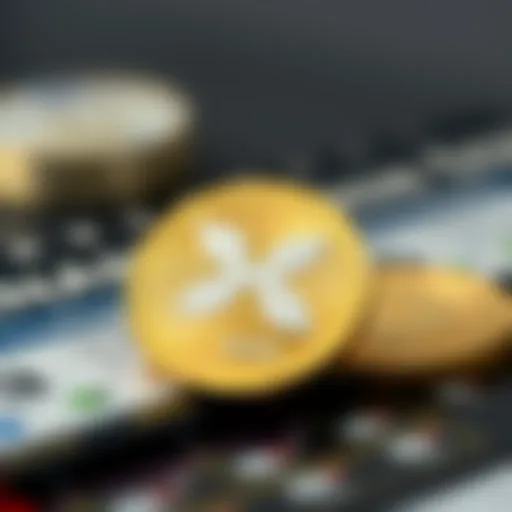Understanding USD ERC20: A Comprehensive Guide


Intro
Navigating the world of cryptocurrencies can feel like trying to read a map in the dark. Each token, with its unique intricacies, plays a distinct role in the vast realm of digital assets. One such token that has made its mark is the USD ERC20. This guide aims to illuminate understanding of USD ERC20, from its core fundamentals to its real-world applications, riding the waves of the Ethereum blockchain's vibrant ecosystem.
In the sections that follow, we’ll unpack a variety of topics that shed light on this popular token. Whether you're an investor sizing up potential gains, an analyst looking for sound information, or a developer delving into its code, there's something to grasp about USD ERC20.
Crypto Concepts Explained
Before diving deep into USD ERC20 itself, it's essential to grasp some foundational concepts that underpin its existence and functionality.
Key Terminology and Definitions
To engage with USD ERC20 effectively, you must be familiar with some key terms:
- ERC20: This is a technical standard for tokens on the Ethereum blockchain, allowing them to interact seamlessly with various wallets and exchanges.
- Token: A digital asset created on a blockchain, often representing a unit of value.
- Ethereum: A decentralized platform that allows developers to create and deploy smart contracts in a decentralized manner.
Understanding these terms is like having a compass while charting your course through a dense forest; it helps you to navigate and make sense of the surrounding terrain.
Practical Applications of Blockchain Technology
USD ERC20 isn't just an abstract concept. Its practical applications span various fields:
- Decentralized Finance (DeFi): USD ERC20 can be used in lending platforms or yield farming, providing liquidity while earning interest.
- Remittances: By leveraging the speed and low costs of transactions, USD ERC20 serves as a swift medium for cross-border transfers.
- Smart Contracts: It allows for automated agreements without intermediaries, reducing costs and errors.
This versatility renders USD ERC20 a valuable asset in the crypto toolkit. Understanding how it functions in these contexts elevates your grasp of its significance in today's digital economy.
Investment Strategies
For those interested in utilizing USD ERC20 within their portfolios, developing an informed strategy is vital.
Analyzing Market Trends and Indicators
Being in the know about market trends can set a savvy investor apart:
- Price Action: Observing price swings and historical performance can offer insights into future movements.
- Volume Trends: Keeping an eye on trading volumes can provide clues on market sentiment surrounding USD ERC20.
By mastering these indicators, you can make informed choices about when to enter or exit trades, ideally maximizing returns.
Risk Management Techniques
Investing inherently carries risks. Here's how to manage them:
- Diversification: Don't put all your eggs in one basket. Spread investments across various assets to mitigate risk.
- Set Stop-Loss Orders: This helps you to limit potential losses by establishing a predetermined exit point.
By employing these strategies, you can protect your investments in the unpredictable crypto landscape.
"In the world of cryptocurrencies, knowledge is power. The more you understand, the better equipped you are to make astute decisions."
With this foundation in place, the following sections will delve deeper into USD ERC20 itself, highlighting its mechanism, safety features, and future outlook, allowing for a comprehensive understanding of this essential token.
Prelude to USD ERC20
In the rapidly evolving cryptocurrency landscape, the USD ERC20 token emerges as a significant player, beating at the heart of the Ethereum ecosystem. Understanding this token isn't just a niche interest for cryptocurrency enthusiasts; it's vital for anyone wanting to navigate the intricate web of digital currencies and decentralized finance.
Defining USD ERC20
USD ERC20 can be seen as a crucial bridge between traditional finance and the burgeoning world of decentralized applications. Essentially, it’s a token built on the Ethereum blockchain that follows the ERC20 standard. This standard details a set of rules, allowing developers to create their tokens in a consistent manner. With USD ERC20, you see the fusion of the reliability of the US dollar and the innovation of blockchain technology.
Thus, if someone talks about USD ERC20, they’re referring to a stablecoin that aims to maintain parity with the US dollar, offering the stability investors often seek in the volatile crypto market.
Origins of USD ERC20 Tokens


The story of USD ERC20 is not just about its creation, but about the increasing demand for stable digital assets in an often tumultuous market. The origins can be traced back to the 2017 cryptocurrency boom when the need for stability became apparent. As investors flooded into the market, many sought tokens that wouldn’t whimsically rise or fall like their counterparts. USD ERC20 tokens were born out of this necessity, allowing investors to shelter their funds among a sea of volatility.
Many developers quickly jumped on board, crafting their own versions of tokens that adhered to the ERC20 framework, leading to a surge in the market. This allowed for a plethora of stablecoins to blossom, each aiming to provide a safe harbor for crypto traders and users.
The growth of USD ERC20 tokens represents a balancing act in the crypto world, where innovation and stability are often at odds.
In summary, introducing USD ERC20 is not simply about stating facts; it's about weaving a narrative that encompasses its definition, significance, and the history that led to its emergence. This token’s role is a response to the evolving demands of the market, one that continues to attract interest from investors, developers, and analysts alike. As we delve deeper into its functionalities and features, we’ll see how USD ERC20 can influence transactions, exchanges, and the future of decentralized finance.
The ERC20 Standard
The ERC20 standard serves as a cornerstone for token creation on the Ethereum blockchain. It defines a set of rules and regulations that govern how tokens can be transferred and interact with other contracts within the ecosystem. This definition is not just a technical necessity; it helps establish a level of consistency and reliability that fosters trust among users and developers alike.
Understanding ERC20 Protocol
To truly grasp the significance of the ERC20 standard, one must first delve into the protocol itself. Created in 2015, ERC20 stands for Ethereum Request for Comments 20, a proposal that significantly influenced the way tokens operate within Ethereum's thriving decentralized applications.
The protocol delineates six mandatory functions that a token must implement:
- : This function returns the total circulating supply of the token.
- : This checks the balance of tokens held by individual addresses.
- : This allows a token owner to send tokens to another address.
- : This enables a token owner to delegate their transfer rights to another address.
- : This specifies an allowance for another address to spend a specific amount of tokens on behalf of the owner.
- : This function checks the remaining number of tokens that a spender can transfer from the owner's account.
These functions establish the bare minimum requirements for compatibility with the broad spectrum of wallets, exchanges, and decentralized finance (DeFi) applications.
Significant Features of ERC20 Tokens
ERC20 tokens offer several notable features, making them an attractive option for developers and users. These features include but are not limited to:
- Interoperability: As a widely adopted standard, ERC20 tokens can easily interact with various services and platforms on the Ethereum network. This compatibility encourages the development of a diverse ecosystem.
- Standardization: The clear guidelines set by the ERC20 standard facilitate easier integration into wallets and exchanges, allowing tokens to gain more visibility.
- Incentives for Development: Having a standard encourages developers to create applications and services around these tokens, maximizing their utility and potential impact.
- Liquidity: The ability of ERC20 tokens to be traded on numerous exchanges boosts liquidity, making it easier for users to buy, sell, or trade their holdings.
These features collectively contribute to the vibrant operational capacity of ERC20 tokens, allowing them to flourish in various use cases, from Initial Coin Offerings (ICOs) to DeFi applications.
Advantages of ERC20 Implementation
Implementing the ERC20 standard comes with several advantages:
- Easy Deployment: Developers find it relatively simple to create new tokens using templates and guidelines laid out by the ERC20 standard. This simplicity accelerates innovation.
- Ecosystem Support: Since many existing platforms already support ERC20, new tokens enter a well-established network, increasing their chances for adoption.
- Trust Factor: Users often feel more secure using ERC20 tokens given their standardized nature, which has undergone rigorous scrutiny over time.
- Smart Contract Functionality: Tokens created using this standard can have added functionalities via smart contracts, allowing for advanced use cases such as automated liquidity provision.
In summary, the ERC20 standard is more than just a set of rules; it is an essential framework that catalyzes the development and trading of tokens in the Ethereum ecosystem. Through its standardization, it paves the way for innovation, security, and efficiency in the blockchain world.
Transaction Mechanics of USD ERC20
Understanding the transaction mechanics of USD ERC20 is crucial. These transactions form the backbone of interaction within the Ethereum system, empowering users to send, receive, or even trade tokens efficiently. So, what makes these mechanics tick? The answer lies in how transactions are structured, the costs associated with performing them, and the various scenarios where they can be utilized.
How Transactions Work
When a user wants to conduct a transaction using a USD ERC20 token, they need to initiate it through a compatible wallet. Here's a quick breakdown of the steps involved:
- Wallet Initiation: The user opens their wallet application. This could be a software wallet like MetaMask or a hardware wallet like Ledger. Initially, they need to ensure that their balance is adequate.
- Transaction Creation: Here, the user specifies the recipient's address and the amount of tokens to be sent. At this stage, it may seem straightforward, but behind the scenes, there are complex elements in play.
- Smart Contracts in Action: Once confirmed, the transaction triggers a smart contract that dictates the rules under which the tokens can be transferred. This ensures that all necessary conditions, such as sufficient balance, are met before proceeding.
- Broadcasting the Transaction: The transaction is then broadcasted to the Ethereum network. Miners receive it, competing to validate and add it to the blockchain. This step is vital for ensuring that the transaction is legitimate and prevents double spending.
- Confirmed Transaction: Once the miners validate the transaction, it is confirmed and becomes part of the blockchain. The user can track its status in real-time through blockchain explorers like Etherscan.
The entire process typically takes a few seconds to minutes, depending on network congestion.
Gas Fees and Cost Implications
Speaking of transactions, one of the first things that come up is gas fees. Gas fees are essentially the price users pay to miners for processing their transactions. Think of gas as the fuel for the Ethereum network. The higher the demand for transactions, the steeper the gas prices climb. Here’s what you need to keep in mind:
- Variable Costs: Gas fees vary based on several factors, including network congestion and complexity of the transaction. A simple token transfer usually requires less gas than a complex one involving multiple smart contracts.
- Calculating Fees: Wallets typically display fees before a transaction is confirmed, allowing users to gauge how much they need to pay. A standard transaction might cost anywhere from a few cents to several dollars, depending on the aforementioned factors.
- Budget Impact: Regular traders and developers often factor these fees into their budgets. Frequent transactions could render ERC20 tokens less appealing for micro-transactions, compelling users to strategize their operations.
"Gas fees can sometimes feel like a toll on the highway—necessary, but at times, quite the burden!"
Use Cases in Different Scenarios
The versatility of USD ERC20 tokens lets them shine in multiple scenarios. Below are examples of how they can be applied across various contexts:
- Remittances: Sending money abroad efficiently is a prevalent use case. Traditional wire transfers often incur hefty fees and delays. In contrast, utilizing USD ERC20 can minimize costs while expediting the process.
- Decentralized Finance (DeFi): Many platforms in the DeFi space accept USD ERC20, enabling users to lend, borrow, or earn interest on their token holdings. These functionalities offer new avenues for managing financial assets without intermediaries.
- Tokenization of Assets: USD ERC20 tokens can represent real-world assets, making it easier to trade them. For example, an individual could fractionalize ownership of a property into ERC20 tokens, allowing smaller investors to participate.
- Purchasing Goods and Services: Online marketplaces are beginning to accept USD ERC20 as a mode of payment. This trend is gaining traction, especially among retailers who embrace crypto payments.


Each of these scenarios highlights the practical applicability of USD ERC20 tokens across diverse transactions, showcasing their significance in a shifting economic landscape.
Wallet Compatibility
For those navigating the waters of cryptocurrency, understanding wallet compatibility is like finding the right key for a locked door. In the context of USD ERC20, this compatibility is crucial for investors, developers, and everyday users alike. It dictates how efficiently one can store, transfer, or trade these tokens. An incompatible wallet could lead to frustration, lost tokens, or in the worst-case scenario, complete inaccessibility.
Types of Wallets Supporting USD ERC20
When it comes to managing USD ERC20, various wallet types are available. Each has its strengths and weaknesses, and picking the right one can depend on individual needs. Here are the primary categories:
- Hot Wallets: These are connected to the internet. They are generally user-friendly and suitable for transactions. Examples include MetaMask and Trust Wallet.
- Cold Wallets: Unlike hot wallets, these are offline and provide enhanced security. Options like Ledger and Trezor fall in this category. They are ideal for long-term holding of tokens, as they protect against online threats.
- Web Wallets: Accessed through a web browser, these wallets make it easy to trade on exchanges, like Coinbase. However, they come with increased risks if the exchange is compromised.
- Mobile Wallets: Tailored for smartphones, these wallets allow for quick and easy transactions. Cex.io is an example where users can manage their holdings on the go.
Each wallet type aligns with different user preferences, lifestyles, and trading strategies. Understanding these options helps users to select a wallet that best matches their needs.
Security Measures for Wallets
While various wallets are available, ensuring security should always be top of mind. Risks are prevalent in the cryptocurrency space, and it’s easy to overlook basic security measures. Here are some practical steps for safeguarding USD ERC20:
- Two-Factor Authentication (2FA): Enabling 2FA provides an extra layer of security. Whether logging into an exchange or accessing a wallet, this measure makes it harder for unauthorized users to gain access.
- Backup Regularly: It's vital to keep backups of wallet information. A good practice is to record recovery phrases and store them securely, away from prying eyes.
- Beware of Phishing Scams: Scammers often use impersonation tactics to obtain sensitive information. Users must always verify URLs or contact support directly to confirm legitimacy.
- Software Updates: Keeping wallet software up to date ensures that users benefit from the latest security patches. Ignoring updates can expose wallets to vulnerabilities.
- Use Hardware Wallets for Long-term Holdings: For those looking to hold their USD ERC20 tokens for an extended period, hardware wallets offer the best protection against theft or hacking.
Wallet compatibility is more than just a checklist; it’s about ensuring peace of mind while venturing through the dynamic landscape of cryptocurrency. The right choice for users hinges not only on ease of use but also on robust security protocols.
“In the world of cryptocurrency, a secure wallet isn’t just a luxury; it’s a necessity.”
Exchanges and Trading Platforms
The realm of USD ERC20 is inextricably linked to exchanges and trading platforms, which serve as the lifeblood for trading activities. These platforms facilitate the buying, selling, and swapping of USD ERC20 tokens, making it essential for any serious player in the cryptocurrency game to grasp their workings. Both novice and seasoned investors need to have a solid understanding of how to navigate these platforms, as they provide the primary interface for engaging with the market.
The importance of trading platforms lies not only in their operational function but also in their various features that can significantly impact trading success. The choice of exchange can yield different benefits depending on factors like transaction fees, user interface, trading pairs available, and security measures in place. A well-chosen platform can enhance an investor's experience, streamlining the process as they maneuver through the ups and downs of the crypto market.
Popular Exchanges for USD ERC20
When discussing the leading exchanges for USD ERC20, several prominent names could easily come to mind. Let’s break down a few of the most noteworthy ones:
- Binance: Known as one of the largest exchanges, Binance offers an extensive variety of trading pairs with USD ERC20, appealing to many traders.
- Coinbase: Especially user-friendly for beginners, Coinbase provides a straightforward platform where USD ERC20 can be purchased with ease.
- Kraken: Recognized for its robust security measures, Kraken offers several advanced features that can benefit professional traders.
- Huobi: A popular choice in Asia, Huobi presents a broad array of cryptocurrencies and various functionalities that cater to different trading styles.
- Bitfinex: Known for its high liquidity, Bitfinex supports USD ERC20 trading with several advanced trading options and tools for analysis.
All these exchanges offer distinct user experiences and advantages, making it important to choose the right fit for your trading goals.
Before registering on any platform, investors should research trading fees, liquidity levels, and security protocols. This diligence helps prevent future headaches and ensures that they engage in a stable, trustworthy environment. Also, taking into account the level of support provided by each exchange can make a significant difference, especially in volatile market conditions.
Trading Strategies for Investors
Investing in USD ERC20 calls for a well-rounded strategy that aligns with individual risk tolerance and market conditions. Successful traders employ various strategies, adapting as needed to capitalize on market movements. Here are some popular trading strategies worth considering:
- Day Trading: This involves making multiple trades within a single day based on price fluctuations, allowing investors to take advantage of short-term volatility.
- HODLing: A long-term approach where investors buy USD ERC20 and hold onto it for an extended period, banking on its appreciation over time.
- Swing Trading: Traders look for the right moment to make a profit from short to medium-term trends in USD ERC20, holding assets for a few days to weeks.
- Scalping: A fast-paced method that entails making dozens or hundreds of trades within a day to achieve small profits on each transaction.
- Arbitrage: This strategy leverages price discrepancies across different exchanges, allowing investors to buy at a lower price on one platform and sell at a higher price on another.
Choosing the right trading strategy hinges upon understanding one’s own objectives and risk appetite. Keeping an eye on market trends, potential regulatory changes, and tech developments related to USD ERC20 is crucial. In this volatile environment, a good strategy coupled with timely information can make all the difference in successful trading.
Regulatory Landscape
The regulatory landscape surrounding USD ERC20 plays a crucial role in how the token operates within the cryptocurrency ecosystem. Innovations in blockchain technology often outpace regulatory frameworks, leading to a complex environment of compliance and governance. As USD ERC20 gains more traction, regulatory considerations become pivotal in determining its usability and acceptance in the financial world. Regulatory guidelines not only shape investor confidence but also dictate how exchanges operate, impact liquidity, and influence market behavior.
Global Regulation on USD ERC20
From the U.S. Securities and Exchange Commission's perspective to the European Union's evolving framework, regulations impact the existence and function of USD ERC20 tokens significantly. In countries like the United States, the regulatory body has taken a robust stance toward cryptocurrencies, wary of their potential for misuse. Rules concerning anti-money laundering, know your customer (KYC) requirements, and tax obligations must be adhered to by all entities dealing with USD ERC20 tokens.
In other parts of the globe, regulations vary vastly. For instance, in regions like Asia, particularly in countries such as Singapore and Japan, the approach tends to be more lenient compared to their Western counterparts. These discrepancies create a patchwork of regulations, where a USD ERC20 token may be compliant in one jurisdiction but face stringent restrictions in another. Regulatory bodies often engage in consultations with industry stakeholders to fine-tune frameworks that balance innovation with consumer protection.
Impact of Regulations on Trading


Regulations considerably affect trading conditions for USD ERC20 tokens, intertwining with liquidity, market access, and overall trading strategies. When regulations are clear and balanced, they create a safer trading environment that can enhance participant trust in the market. For traders and investors, this confidence translates into increased trading volumes and can result in better price stability.
On the flip side, overly restrictive regulations may deter trading activities, causing participants to flee to less regulated territories or unregulated platforms. This concern impacts market depth and could lead to greater volatility as trades become more concentrated. Moreover, compliance costs can be daunting for smaller players in the market, potentially pushing them out and creating an oligopolistic environment dominated by a few large entities.
Effective regulation is not about stifling innovation, but about crafting a supportive framework that can harness the potential of USD ERC20 while ensuring consumer safety and market integrity.
In summary, understanding the regulatory environment is more than just staying compliant; it offers insight into emerging opportunities and potential pitfalls in trading USD ERC20 tokens.
Risks and Challenges
Understanding the landscape of USD ERC20 involves recognizing the inherent risks and challenges it presents. While the potential for profit and utility is significant, it is equally critical to navigate the pitfalls that could derail investments or compromise security. Investors, developers, and analysts alike must grapple with various elements impacting the stability and viability of USD ERC20 in a rapidly evolving market.
Market Volatility Concerns
Market volatility is a double-edged sword in the realm of cryptocurrencies. On one side, it creates opportunities; on the other, it introduces significant risks. USD ERC20 does not exist in a vacuum; its value is tethered to the broader cryptocurrency market and influenced by numerous factors.
- Price Fluctuations: The price of USD ERC20 can swing dramatically within short timeframes. Such volatility can stem from market sentiment, macroeconomic indicators, and developments specifically within the Ethereum ecosystem. A sudden market sell-off, for instance, could send prices plummeting, affecting both traders and holders.
- Investment Psychology: Investor behavior significantly impacts market conditions. Fear and greed can lead to panic selling or speculative buying, both of which can exacerbate volatility. This erratic behavior may deter long-term investors who prefer a stable environment for their assets.
- Liquidity Issues: During periods of heightened volatility, liquidity may dwindle as investors become hesitant to buy or sell. A lack of liquidity can lead to price slippage, where transactions occur at unfavorable prices due to insufficient buy or sell orders at a desired price point.
"Investors must exercise caution, as the very nature of cryptocurrencies, including USD ERC20, is intertwined with unpredictability."
Overall, while volatility can present trading opportunities, it necessitates a careful approach to risk management and a strong understanding of market dynamics.
Security Vulnerabilities
Security remains one of the most pressing concerns for anyone dealing with USD ERC20 tokens. Despite the innovations in blockchain technology, vulnerabilities persist that could undermine investor confidence and overall market stability.
- Smart Contract Risks: One of the main attractions of USD ERC20 is its reliance on smart contracts. However, poorly coded contracts can lead to significant losses. Bugs or vulnerabilities in the code can be exploited by malicious actors, resulting in token theft or freezing of assets.
- Phishing and Scams: The decentralized nature of cryptocurrencies often makes users targets for scams. Phishing attacks, where users are tricked into providing private keys or passwords, can lead to irrevocable losses. Awareness and education are crucial in safeguarding assets.
- Exchange Risks: Many investors store their USD ERC20 tokens on exchanges, which can be hotbeds for hacking incidents. If an exchange is compromised, users risk losing their funds entirely. Thus, it is vital to understand the security measures each exchange employs before depositing tokens.
Future of USD ERC20
As the cryptocurrency market continues to evolve, the future of USD ERC20 paints an intriguing picture full of possibilities. Understanding this trajectory is crucial for investors and developers alike, as it can substantially affect decision-making processes, investment strategies, and technological advancements within the blockchain arena. The growth of USD ERC20 not only influences individual investors but also plays a significant role in the larger cryptocurrency ecosystem, presenting opportunities and challenges.
Trends Influencing USD ERC20 Growth
Several key trends are shaping the landscape for USD ERC20, each with its own set of implications:
- Increasing Adoption in DeFi: Decentralized finance or DeFi has been gaining considerable traction. As more platforms integrate USD ERC20, it enhances liquidity and utility, thereby increasing its demand. This trend encourages many users to take advantage of smart contract-based loans and yield farming.
- Regulatory Acceptance: Recent movements towards regulatory clarity around cryptocurrencies are paving the path for more institutional investors to consider USD ERC20. As regulations become more defined, it nurtures an environment of trust and legitimacy, attracting more participation from traditional financial sectors.
- Stablecoin Popularity: USD ERC20 functions alongside a broader category—stablecoins. The demand for stability in value especially during volatile market conditions pushes USD ERC20 into the spotlight, as its pegged nature attracts both cautious investors and burgeoning organizations.
- Enhanced User Experience: Advances in user interfaces and accessibility have opened the doors for more individuals to engage with USD ERC20. Simplifying the onboarding process allows for wider adoption among casual users who might have previously found cryptocurrency intimidating.
These trends not only sustain growth but also suggest a promising future for USD ERC20 as a leading digital currency in the Ethereum ecosystem.
Technological Innovations on the Horizon
As we look toward the future, several technological innovations stand to bolster USD ERC20's functionality and appeal:
- Layer 2 Solutions: Innovations like Polygon and Optimism aim to address Ethereum's scalability issues. By leveraging layer 2 platforms, USD ERC20 can become more efficient—enhancing transaction speeds and reducing costs, making it more appealing for day-to-day transactions.
- Cross-Chain Interoperability: As various blockchains strive for compatibility, the potential for USD ERC20 to operate seamlessly across different platforms emerges. Initiatives like Polkadot and Cosmos could bridge multiple ecosystems, allowing USD ERC20 to reach a broader audience.
- Smart Contract Enhancements: Improvements in smart contract protocols can lead to more secure and efficient transaction processes. With advances in coding languages or contract frameworks, the potential for developing more complex financial products surrounding USD ERC20 could significantly increase.
The future of USD ERC20 is intertwined with technological advancements, and those who adapt quickly stand to benefit the most.
- Adoption of AI and Machine Learning: Utilizing AI can help in optimizing trading strategies and market predictions, providing an edge for USD ERC20 traders. Insights derived from data analysis can help inform investment choices, enhancing overall trading efficiency.
Culmination
In summary, the exploration of USD ERC20 delves deeply into its pivotal role within the sprawling cryptocurrency realm. This article highlights the various dimensions that intertwine with the use and proliferation of these tokens, emphasizing their practicality in day-to-day transactions, trading platforms, and decentralized finance.
Recapping Key Points
- Identity and Origins: USD ERC20 tokens aren't just faceless entries on a blockchain. They signify a blend of traditional finance and innovative technology, rooted in Ethereum's framework that expands their usability across borders.
- Transaction Mechanics: Navigating the flow of USD ERC20 transactions reveals an efficient system, delineated by gas fees, making the process of sending and receiving funds relatively smooth. The low entry barriers offer seasoned investors and newcomers alike the opportunity to engage.
- Market Landscape: The cryptocurrency exchanges compatible with USD ERC20 tokens act as gateways for countless users riding the crypto wave. These platforms are essential, not only for trading purposes but also for keeping the market active and agile.
- Security and Compliance: Diving into the regulatory aspects underscores the effort to maintain credibility in the volatile landscape. While challenges like market volatility exist, security measures mitigate potential vulnerabilities, promoting trust among users.
- Future Prospects: The anticipated trends and technological advancements might shape how USD ERC20 functions moving forth. A keen observation of these changes can provide insight into potential investment opportunities.
Final Thoughts on USD ERC20
The evolution of USD ERC20 has not only contributed to the ecosystem of digital assets but also symbolizes the shift towards a more decentralized financial landscape. While challenges persist, the ongoing innovations and regulatory adjustments hint at a bright horizon.
Embracing USD ERC20 isn't merely about investing; it's about recognizing a fundamental change in how we perceive value in the digital age. Participation in this realm requires due diligence and an informed perspective, inviting a wide array of stakeholders—from investors and developers to enthusiasts and educators—to be part of this transformative journey. The interest in these tokens is just the surface of what's available, and understanding them may unlock new pathways to financial engagement in a rapidly evolving environment.
"The only way to do great work is to love what you do." — Steve Jobs
For those eager to dive deeper into USD ERC20, resources such as Wikipedia, Britannica, and community discussions on sites like Reddit can provide a wealth of knowledge.















